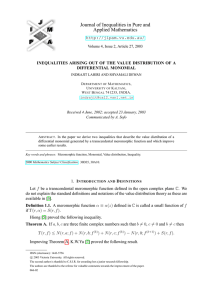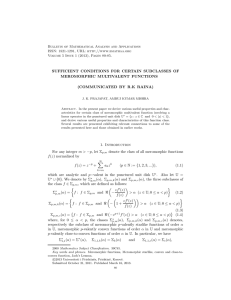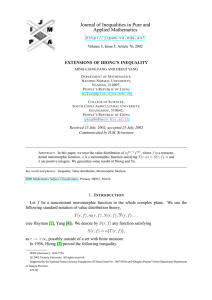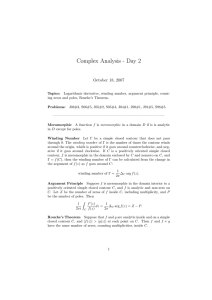Document 10940082
advertisement
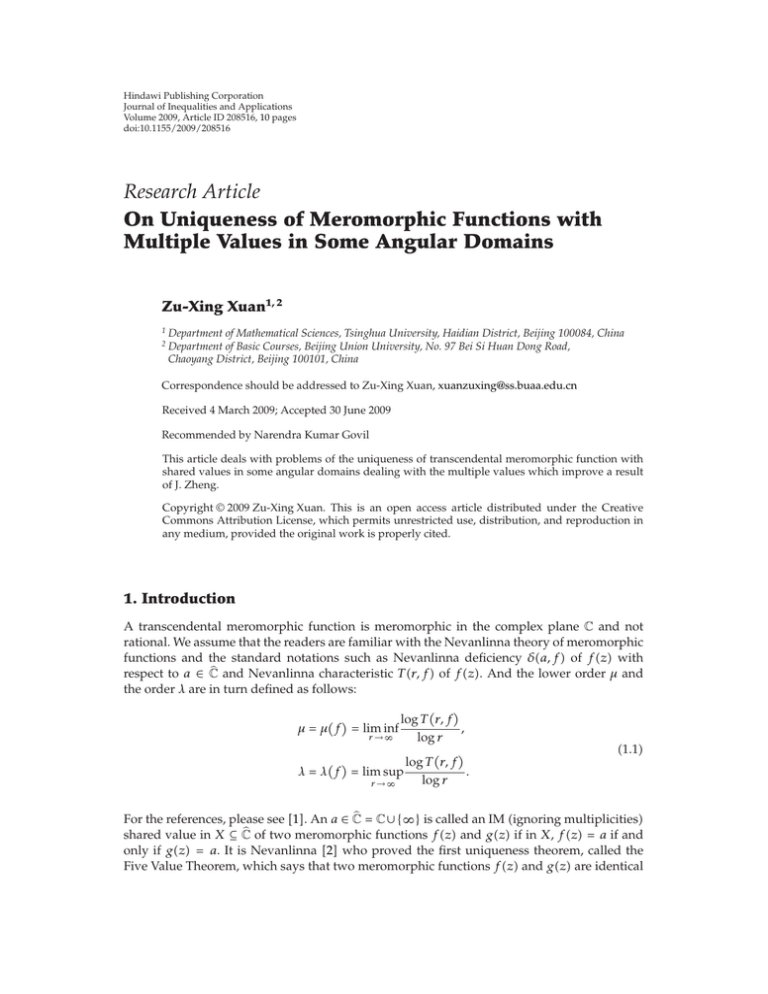
Hindawi Publishing Corporation
Journal of Inequalities and Applications
Volume 2009, Article ID 208516, 10 pages
doi:10.1155/2009/208516
Research Article
On Uniqueness of Meromorphic Functions with
Multiple Values in Some Angular Domains
Zu-Xing Xuan1, 2
1
2
Department of Mathematical Sciences, Tsinghua University, Haidian District, Beijing 100084, China
Department of Basic Courses, Beijing Union University, No. 97 Bei Si Huan Dong Road,
Chaoyang District, Beijing 100101, China
Correspondence should be addressed to Zu-Xing Xuan, xuanzuxing@ss.buaa.edu.cn
Received 4 March 2009; Accepted 30 June 2009
Recommended by Narendra Kumar Govil
This article deals with problems of the uniqueness of transcendental meromorphic function with
shared values in some angular domains dealing with the multiple values which improve a result
of J. Zheng.
Copyright q 2009 Zu-Xing Xuan. This is an open access article distributed under the Creative
Commons Attribution License, which permits unrestricted use, distribution, and reproduction in
any medium, provided the original work is properly cited.
1. Introduction
A transcendental meromorphic function is meromorphic in the complex plane C and not
rational. We assume that the readers are familiar with the Nevanlinna theory of meromorphic
functions and the standard notations such as Nevanlinna deficiency δa, f of fz with
and Nevanlinna characteristic T r, f of fz. And the lower order μ and
respect to a ∈ C
the order λ are in turn defined as follows:
log T r, f
,
μ μ f lim inf
r →∞
log r
log T r, f
λ λ f lim sup
.
log r
r →∞
1.1
C ∪ {∞} is called an IM ignoring multiplicities
For the references, please see 1. An a ∈ C
shared value in X ⊆ C of two meromorphic functions fz and gz if in X, fz a if and
only if gz a. It is Nevanlinna 2 who proved the first uniqueness theorem, called the
Five Value Theorem, which says that two meromorphic functions fz and gz are identical
2
Journal of Inequalities and Applications
if they have five distinct IM shared values in X C. After his very fundamental work,
the uniqueness of meromorphic functions with shared values in the whole complex plane
attracted many investigations see 3. Recently, Zheng in 4 suggested for the first time the
and this is an
investigation of uniqueness of a function meromorphic in a precise subset of C,
interesting topic.
Given m pair of real numbers {αj , βj } satisfying
−π ≤ α1 < β1 ≤ α2 < β2 ≤ · · · ≤ αm < βm ≤ π,
1.2
we define
ω max
π
π
,...,
.
β1 − α1
βm − αm
1.3
Zheng in 4 proved the following theorem.
Theorem A. Let fz and gz be both transcendental meromorphic functions, and let fz be of
and an integer p ≥ 0, δ δa, f p > 0. For m pair of
finite order λ and such that for some a ∈ C
real numbers {αj , βj } satisfying 1.2 and
m
αj1 − βj
j1
δ
,
2
4
< arcsin
σ
where σ max{ω, μ}, assume that fz and gz have five distinct IM shared values in X αj ≤ arg z ≤ βj }. If ω < λf, then fz ≡ gz.
1.4
m
j1 {z
:
However, it was not discussed whether there are similar results dealing with multiple
values in some angular domains. In this paper we investigate this problem.
We use Ek a, X, f to denote the set of zeros of fz − a in X, with multiplicities no
greater than k, in which each zero counted only once.
Our main result is what follows.
Theorem 1.1. Let fz and gz be both transcendental meromorphic functions, and let fz be of
and an integer p ≥ 0, δ δa, f p > 0. For m pair of
finite order λ and such that for some a ∈ C
real numbers {αj , βj } satisfying 1.2 and
m
αj1 − βj
j1
4
< arcsin
σ
δ
,
2
1.5
Journal of Inequalities and Applications
3
where σ max{ω, μ}, assume that aj j 1, 2, . . . , q are q distinct complex numbers, and let
kj j 1, 2, . . . , q be positive integers or ∞ satisfying
k1 ≥ k2 ≥ · · · ≥ kq ,
Ekj aj , X, f Ekj aj , X, g ,
q
kj
> 2,
k 1
j3 j
where X q
j1 {z
1.6
1.7
1.8
: αj ≤ arg z ≤ βj }. If ω < λf, then fz ≡ gz.
2. Proof of Theorem 1.1
First we introduce several lemmas which are crucial in our proofs. The following result was
proved in 5 also see 6.
Lemma 2.1 see 5. Let fz be transcendental and meromorphic in C with the lower order 0 ≤
μ < ∞ and the order 0 < λ ≤ ∞. Then for arbitrary positive number σ satisfying μ ≤ σ ≤ λ and a set
E with finite linear measure, there exists a sequence of positive numbers {rn } such that
1 rn ∈ E, limn → ∞ r n /n ∞,
2 lim infn → ∞ log T rn , f/ log rn ≥ σ,
3 T t, f < 1 o1t/rn σ T rn , f, t ∈ rn /n, nrn .
A sequence rn satisfying 1, 2, and 3 in Lemma 2.1 is called Polya peak of order σ
outside E in this article. For r > 0 and a ∈ C define
1
>
Dr, a : θ ∈ −π, π : log iθ T r, f ,
f re − a log r
1
iθ T r, f .
Dr, ∞ : θ ∈ −π, π : log f re >
log r
1
2.1
2.2
The following result is a special version of the main result of Baernstein 7.
Lemma 2.2. Let fz be transcendental and meromorphic in C with the finite lower order μ and the
δ δa, f > 0. Then for arbitrary Polya peak rn of order
order 0 < λ ≤ ∞ and for some a ∈ C,
σ > 0, μ ≤ σ ≤ λ, we have
⎧
⎫
⎨
δ⎬
4
lim inf mes Drn , a ≥ min 2π, arcsin
.
n→∞
⎩
σ
2⎭
2.3
Although Lemma 2.2 was proved in 7 for the Polya peak of order μ, the same
argument of Baernstein 7 can derive Lemma 2.2 for the Polya peak of order σ, μ ≤ σ ≤ λ.
4
Journal of Inequalities and Applications
Nevanlinna theory on angular domain will play a key role in the proof of theorems.
Let fz be a meromorphic function on the angular domain Ωα, β {z : α ≤ arg z ≤ β},
where 0 < β − α ≤ 2π. Nevanlinna defined the following notations see 8:
ω
Aα,β r, f π
r
1
dt
tω iα 1
te
,
log
−
log
f
f teiβ tω r 2ω
t
2ω
Bα,β r, f πr ω
β
log f reiθ sin ωθ − αdθ,
α
2.4
1
|bn |ω
−
sin ωθn − α,
r 2ω
|bn |ω
1<|bn |<r
Cα,β 2
where ω π/β − α and bn |bn |eiθn are the poles of fz on Ωα, β appearing according
to their multiplicities. Cα,β r, f is called the angular counting function of the poles of f on
Ωα, β and Nevanlinna’s angular characteristic is defined as follows:
Sα,β r, f Aα,β r, f Bα,β r, f Cα,β r, f .
2.5
Throughout, we denote by Rα,β r, ∗ a quantity satisfying
Rα,β r, ∗ O log rSα,β r, ∗ ,
r ∈ E,
2.6
where E denotes a set of positive real numbers with finite linear measure. It is not necessarily
the same for every occurrence in the context 9.
Lemma 2.3. Let fz be meromorphic on Ωα, β. Then for arbitrary complex number a, we have
Sα,β
1
f −a
Sα,β r, f O1,
2.7
and for an integer p ≥ 0,
Sα,β r, f p ≤ 2p Sα,β r, f Rα,β r, f ,
Aα,β
and Rα,β r, f p Rα,β r, f.
f p
r,
f
Bα,β
f p
r,
f
Rα,β r, f ,
2.8
Journal of Inequalities and Applications
5
1 ≤ j ≤ q,
Lemma 2.4. Let fz be meromorphic on Ωα, β. Then for arbitrary q distinct aj ∈ C
we have
q
Cα,β r,
q − 2 Sα,β r, f ≤
j1
1
f − aj
R r, f ,
2.9
where the term Cα,β r, 1/f − aj will be replaced by Cα,β r, f when some aj ∞.
k
We use Cα,β r, 1/f − a to denote the zeros of fz − a in Ωα, β whose multiplicities
k1
are no greater than k and are counted only once. Likewise, we use Cα,β r, 1/f −a to denote
the zeros of fz − a in Ωα, β whose multiplicities are greater than k and are counted only
once.
Lemma 2.5. Let fz be meromorphic on Ωα, β, and let kj j 1, 2, . . . , q be q positive integers.
1 ≤ j ≤ q, we have
Then for arbitrary q distinct aj ∈ C
i
q
q
1
kj
kj 1
1
R r, f ,
Cα,β r,
q − 2 Sα,β r, f <
Cα,β r,
k
1
f
−
a
k
1
f
−
a
j
j
j1 j
j1 j
⎛
ii
⎞
q
kj
kj 1
1
⎝q − 2 −
⎠Sα,β r, f <
R r, f ,
Cα,β r,
k
1
k
1
f
−
a
j
j1 j
j1 j
q
2.10
where the term Cα,β r, 1/f − aj will be replaced by Cα,β r, f when some aj ∞.
Proof. According to our notations, we have
Cα,β r,
1
f −a
k
Cα,β r,
1
f −a
k1
Cα,β
r,
1
f −a
k
k
k1
1
1
1
1
k
Cα,β r,
Cα,β r,
Cα,β r,
k1
f −a
k1
f −a
f −a
k
1
1
k
1
1
1
k
k1
C
C
≤
C
r,
r,
r,
k 1 α,β
f −a
k 1 α,β
f −a
k 1 α,β
f −a
k
k
1
1
1
Cα,β r,
Cα,β r,
.
k1
f −a
k1
f −a
2.11
6
Journal of Inequalities and Applications
By Lemma 2.4,
q
q − 2 Sα,β r, f ≤
Cα,β r,
j1
1
f − aj
R r, f
q
q
1
kj
kj 1
1
R r, f ,
≤
Cα,β r,
Cα,β r,
k
1
f
−
a
k
1
f
−
a
j
j
j1 j
j1 j
2.12
and i follows.
Furthermore, Cα,β r, 1/f − aj < Sα,β r, f, and on combining this with i, we get
ii.
Proof of Theorem 1.1. Suppose fz ≡
/ gz. For convenience, below we omit the subscript of all
the notations, such as Sr, ∗ and Cr, ∗. By applying Lemma 2.5 to g and 1.6, we have
⎞
q
q
kj
kj 1
2k
k
2
2
⎝
r,
R r, g
− 2⎠S r, g ≤
C
k
1
k
1
k
1
g
−
a
j
2
2
j
j3
j1
⎛
k2
1
≤
C r,
R r, g
k2 1
f −g
≤
k2
S r, f − g R r, g
k2 1
≤
k2
k2
S r, f S r, g R r, g ,
k2 1
k2 1
2.13
so that
⎛
⎞
q
kj
k
k2
2
⎝
− 2⎠S r, g − R r, g <
S r, f .
k 1 k2 1
k2 1
j3 j
2.14
This implies that Rr, g Rr, f. We have also 2.14 for alternation of f and g, then
⎞
q
kj
k2
k
2
⎝
− 2⎠S r, f − R r, f <
S r, g ≤ S r, f R r, f .
k 1 k2 1
k2 1
j3 j
⎛
2.15
By 1.8, we have
S r, f O log r ,
r/
∈ E.
2.16
Journal of Inequalities and Applications
7
We assume that a ∈ C. By the same argument we can show Theorem 1.1 for the case
when a ∞. By applying Lemma 2.3 and 2.16, we estimate
1
B r, p
f −a
≤ S r, f p O1
f p
A B r,
A B r, f pC r, f C r, f O1
f
≤ p 1 S r, f R r, f O log r , r /
∈ E.
2.17
The following method comes from 10. But we quote it in detail here because of its
independent significance. Note that λf > ω. We need to treat two cases.
I λf > μ. Then λf p λf > σ ≥ μ μf p . And by the inequality 1.5, we
can take a real number > 0 such that
m
j1
4
arcsin
αj1 − βj 2
2
<
σ 2
δ
,
2
2.18
where αm1 2π α1 , and
λ f p > σ 2
> μ.
2.19
Applying Lemma 2.1 to f p z gives the existence of the Polya peak rn of order σ 2
of f p
∈ E, and then from Lemma 2.2 for sufficiently large n we have
such that rn /
δ
− ,
2
4
mesDrn , a >
arcsin
σ 2
2.20
since σ 2
> 1/2. We can assume for all the n, 13 holds. Set
⎛
K : mes⎝Drn , a
⎞
αj , βj − ⎠.
m
"#
2.21
j1
Then from 2.18 and 2.20 it follows that
⎛
K ≥ mesDrn , a − mes⎝0, 2π \
⎞
αj , βj − ⎠
m
#
j1
⎛
mesDrn , a − mes⎝
⎞
βj − , αj1 ⎠
m
#
j1
mesDrn , a −
m
αj1 − βj 2
> > 0.
j1
2.22
8
Journal of Inequalities and Applications
It is easy to see that there exists a j0 such that for infinitely many n, we have
"
K
mes Drn , a
αj0 , βj0 − > .
q
2.23
$
We can assume for all the n, 2.23 holds. Set En Drn , a α − j0 , βj0 − . Thus from the
definition 2.1 of Dr, a it follows that
βj
−
1
dθ ≥
log p iθ f
rn e − a
αj0 0
En
1
dθ
log p iθ f
rn e − a
T rn , f p
≥ mesEn log rn
K T rn , f p
>
.
m log rn
2.24
On the other hand, by the definition 2.4 of Bα,β r, ∗ and 2.14, we have
βj
−
π
1
dθ ≤
log p iθ r ωj0 Bαj0 ,βj0
2ωj0 sin ωj0
f
rn e − a
αj0 0
% j0 r ωj0 log r,
<K
1
r, p
f −a
2.25
r/
∈ E.
Combining 2.24 with 2.25 gives
mK
% j 0 ωj
rn 0 log2 rn .
T rn , f p ≤
K
2.26
Thus from 1.5 in Lemma 2.1 for σ 2
, we have
log T rn , f p
≤ ωj0 ≤ σ .
σ ≤ lim sup
log rn
n→∞
2.27
This is impossible.
II λf μ. Then σ μ λf λf p μf p . By the same argument as in I
with all the σ 2
replaced by σ μ, we can derive
max ω, μ σ ≤ ω < λ f .
2.28
This is impossible. Theorem 1.1 follows.
Remark 2.6. In Theorem A, q 5, k1 k2 k3 k4 k5 ∞, then
k3
k4
k5
3 > 2,
k3 1 k4 1 k5 1
2.29
Journal of Inequalities and Applications
9
so Theorem A is a special case of Theorem 1.1. Meanwhile, Zheng in 4, pages 153–154 gave
some examples to indicate that the conditions are necessary. So the conditions in theorem are
also necessary.
Corollary 2.7. In Theorem 1.1,
i if q 7, then fz ≡ gz,
ii if q 6, k3 ≥ 2, then fz ≡ gz,
iii if q 5, k3 ≥ 3, k5 ≥ 2, then fz ≡ gz,
iv if q 5, k4 ≥ 4, then fz ≡ gz,
v if q 5, k3 ≥ 5, then fz ≡ gz,
vi if q 5, k3 ≥ 6, k4 ≥ 2, then fz ≡ gz,
Corollary 2.8. Let fz and gz be both transcendental meromorphic functions and let fz be of
and an integer p ≥ 0, δ δa, f p > 0. For m
finite lower order μ and such that for some a ∈ C
pair of real numbers {αj , βj } satisfying 1.2 and
m
αj1 − βj
j1
δ
,
2
4
< arcsin
σ
2.30
where σ max{ω, μ}, assume that aj j 1, 2, . . . , q are q 5 2/k distinct complex numbers
satisfying that Ek aj , X, f Ek aj , X, g j 1, 2, . . . , q, where k is an integer or ∞. If ω <
λf, then fz ≡ gz.
Corollary 2.9. Let fz and gz be both transcendental meromorphic functions and let fz be of
and an integer p ≥ 0, δ δa, f p > 0. For m
finite lower order μ and such that for some a ∈ C
pair of real numbers {αj , βj } satisfying 1.2 and
m
αj1 − βj
j1
4
< arcsin
σ
δ
,
2
2.31
where σ max{ω, μ}, assume that aj j 1, 2, . . . , q are q 5 distinct complex numbers satisfying
that E3 aj , X, f E3 aj , X, g j 1, 2, 3, E2 aj , X, f E2 aj , X, g j 4, 5, then fz ≡
gz.
Question 1. For two meromorphic functions defined in C, there are many uniqueness
theorems when they share small functions az is called a small function of fz if
T r, az oT r, fr → ∞ see 3. So we ask an interesting question: are there similar
results when they share small functions in some precise domain X ⊆ C?
Acknowlegment
The work is supported by NSF of China no. 10871108.
10
Journal of Inequalities and Applications
References
1 W. K. Hayman, Meromorphic Functions, Clarendon Press, Oxford, UK, 1964.
2 R. Nevanlinna, Le théorème de Picard-Borel et la Théorie des Fonctions Méromorphes, Gauthier-Villars,
Paris, France, 1929.
3 H. X. Yi and C.-C. Yang, Uniqueness Theorey of Meromorphic Functions, Kluwer Academic Publishers,
Boston, Mass, USA, 2003.
4 J. H. Zheng, “On uniqueness of meromorphic functions with shared values in some angular
domains,” Canadian Mathematical Bulletin, vol. 47, pp. 152–160, 2004.
5 L. Yang, “Borel directions of meromorphic functions in an angular domain,” Sci.Sinica, pp. 149–163,
1979.
6 A. Edrei, “Meromorphic functions with three radially distributed values,” Transactions of the American
Mathematical Society, vol. 78, pp. 276–293, 1955.
7 A. Baernstein, “Proof of Edrei’s spread conjecture,” Proceedings of the London Mathematical Society, vol.
26, pp. 418–434, 1973.
8 A. A. Goldberg and I. V. Ostrovskii, The Distribution of Values of Meromorphic Functions, Nauka,
Moscow, Russia, 1970.
9 L. Yang and C.-C. Yang, “Angular distribution of value of ff ,” Science in China, vol. 37, pp. 284–294,
1994.
10 J. H. Zheng, “On transcendental meromorphic functions with radially distributed values,” Science in
China, vol. 47, pp. 401–416, 2004.
![Mathematics 414 2003–04 Exercises 5 [Due Monday February 16th, 2004.]](http://s2.studylib.net/store/data/010415766_1-b65af2bb66ab8e422354912dcedcb6a6-300x300.png)





